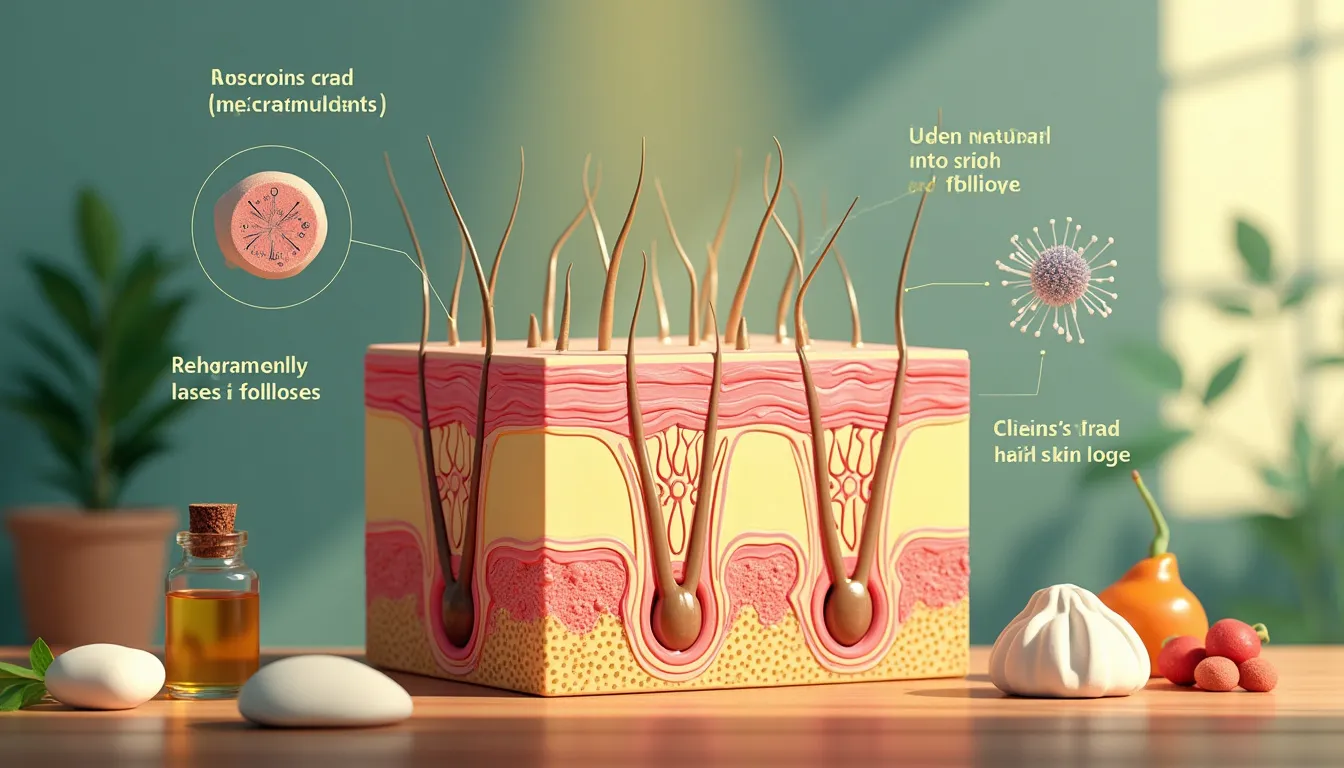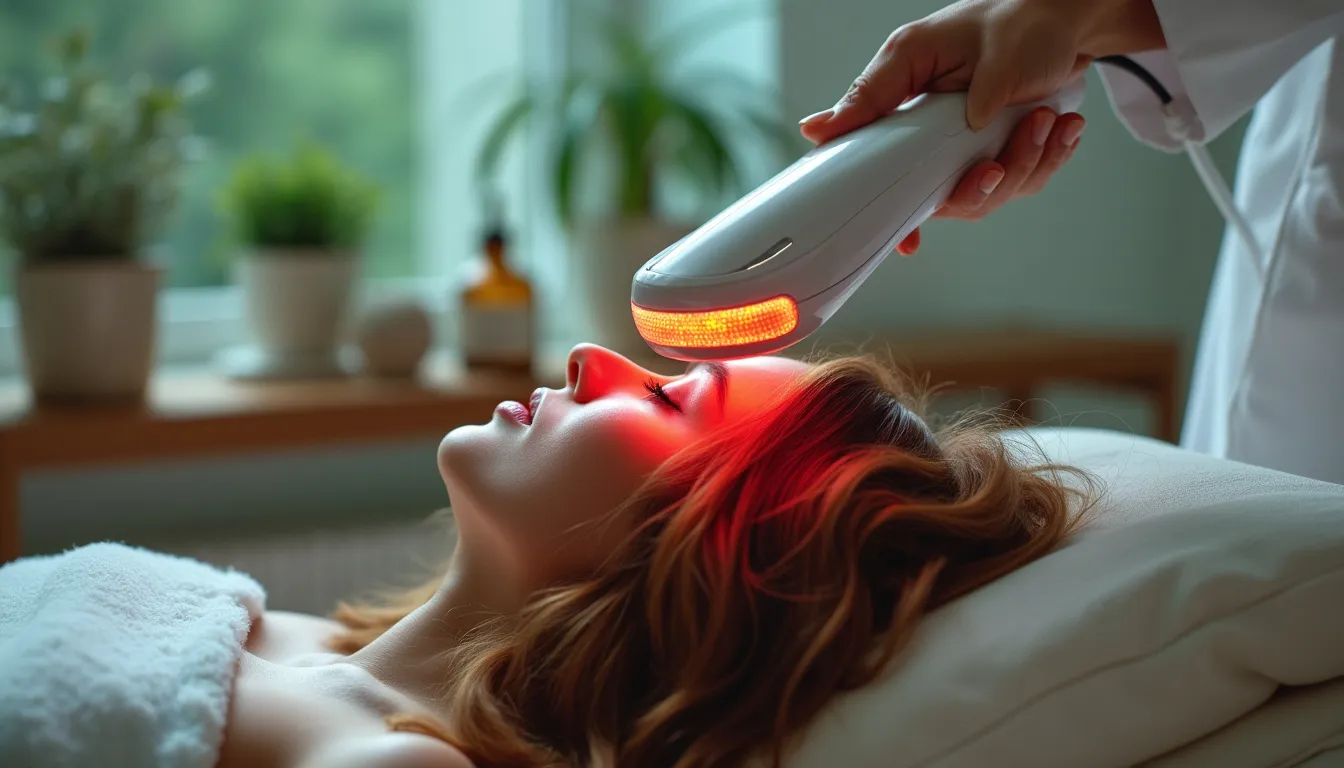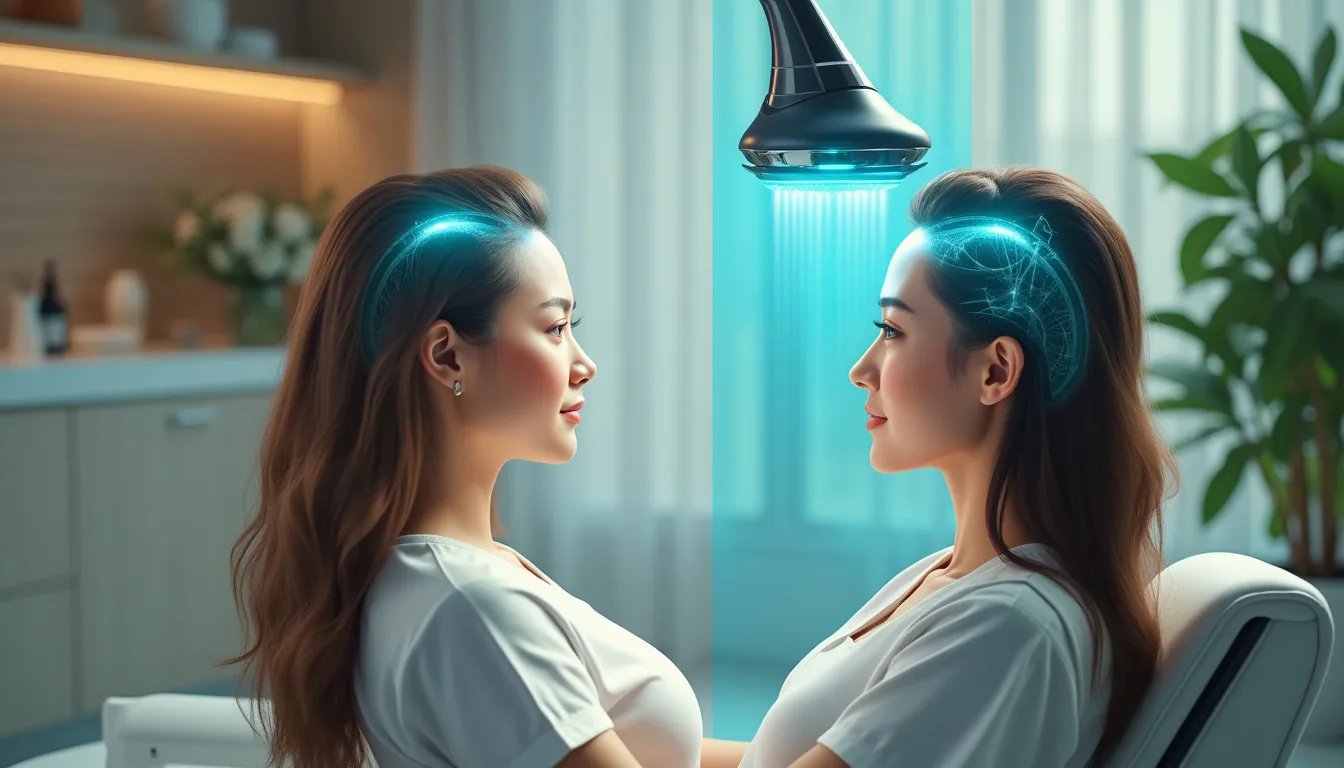Are you tired of watching your hair thin out day by day? Laser hair therapy might just be the groundbreaking solution you’ve been searching for. This innovative approach to combating hair loss has been gaining traction in recent years, offering hope to millions struggling with thinning hair and baldness. Unlike traditional treatments that often come with side effects or invasive procedures, laser hair therapy harnesses the power of light to stimulate hair growth naturally. But what exactly is laser hair therapy, and how does it work its magic on your scalp? In this comprehensive guide, we’ll dive deep into the world of low-level laser therapy (LLLT) for hair loss, exploring its principles, benefits, and the science that backs it up. Whether you’re just starting to notice a receding hairline or you’ve been battling hair loss for years, understanding laser hair therapy could be your first step towards a fuller, healthier head of hair. So, let’s shed some light on this cutting-edge treatment and discover if it could be the key to unlocking your hair’s potential. Ready to explore a brighter future for your locks? Let’s begin!
Introduction to Laser Hair Therapy
Definition and Basic Principles
Laser hair therapy, also known as low-level laser therapy (LLLT) for hair loss, is a cutting-edge, non-invasive treatment that harnesses the power of light to stimulate hair growth and combat hair loss. This innovative approach has gained significant traction in recent years as a promising solution for those struggling with thinning hair or baldness.
At its core, laser hair therapy utilizes specific wavelengths of light to penetrate the scalp and energize hair follicles. This process is based on the principle of photobiomodulation, where light energy is absorbed by cells, triggering a series of biological reactions that promote hair growth and improve overall hair health.
How Laser Hair Therapy Works for Hair Loss
The mechanism behind laser hair therapy is both fascinating and complex. When the low-level laser light is applied to the scalp, it penetrates the skin and is absorbed by the hair follicles. This light energy then stimulates several key processes:
- Increased blood flow: The laser light helps dilate blood vessels in the scalp, improving circulation and delivering more nutrients and oxygen to the hair follicles.
- Enhanced cellular metabolism: The light energy boosts the production of ATP (adenosine triphosphate), the primary energy source for cells, which can help rejuvenate dormant hair follicles.
- Stimulation of protein synthesis: Laser therapy can increase the production of proteins essential for hair growth, such as keratin.
- Reduction of inflammation: The treatment may help reduce scalp inflammation, which can contribute to hair loss in some cases.
These processes work together to create an optimal environment for hair growth, potentially reversing the miniaturization of hair follicles often seen in conditions like androgenetic alopecia (male and female pattern baldness).
Benefits of Laser Hair Therapy Compared to Traditional Treatments
Laser hair therapy offers several advantages over traditional hair loss treatments, making it an attractive option for many individuals:
- Non-invasive: Unlike hair transplant surgeries, laser therapy doesn’t require any incisions or injections, making it a painless and low-risk treatment option.
- No side effects: Traditional medications for hair loss, such as minoxidil or finasteride, can sometimes cause unwanted side effects. Laser hair therapy, when used correctly, has no known side effects.
- Convenience: With the availability of at-home laser devices, treatments can be easily incorporated into one’s daily routine without the need for frequent clinic visits.
- Versatility: Laser hair therapy can be used as a standalone treatment or in combination with other hair loss solutions for potentially enhanced results.
- Suitable for both men and women: Unlike some hair loss treatments that are gender-specific, laser therapy is effective for both male and female pattern baldness.
Moreover, laser hair therapy has shown promising results in treating various types of hair loss, including androgenetic alopecia, alopecia areata, and even chemotherapy-induced hair loss. A study published in Lasers in Medical Science found that LLLT was a safe and effective treatment for hair loss in both men and women.
While the effectiveness of laser hair therapy can vary depending on individual factors such as the type and extent of hair loss, many users report noticeable improvements in hair density, thickness, and overall hair health. Some even experience regrowth in previously balding areas.
It’s important to note that like any hair loss treatment, consistency is key when it comes to laser hair therapy. Results typically become visible after several months of regular use, and ongoing treatments are necessary to maintain the benefits.
As research in this field continues to evolve, laser hair therapy is becoming an increasingly popular choice for those seeking a natural, non-invasive solution to hair loss. Its ability to stimulate hair growth at the cellular level, combined with its safety profile and ease of use, makes it a compelling option in the fight against hair loss.
For those considering laser hair therapy, it’s always advisable to consult with a hair loss specialist or dermatologist to determine if this treatment is suitable for your specific condition. They can provide personalized advice and help you integrate laser therapy into a comprehensive hair loss management plan.
Ready to take the next step in your hair restoration journey? Consider exploring Fortify, a program designed to help stop hair loss and promote healthier, fuller hair.

The Science Behind Laser Hair Therapy
Understanding the science behind laser hair therapy is crucial for anyone considering this innovative treatment for hair loss. This cutting-edge technology harnesses the power of light to stimulate hair growth and combat various forms of alopecia. Let’s delve into the fascinating world of low-level laser therapy (LLLT) and explore how it works its magic on our scalps.
Low-Level Laser Therapy (LLLT) Technology
Low-level laser therapy, also known as photobiomodulation, is the cornerstone of laser hair therapy. This non-invasive treatment uses red or near-infrared light to penetrate the scalp and interact with hair follicles. Unlike high-powered lasers used for cutting or ablation, LLLT devices emit light at lower power levels, typically between 5 and 500 milliwatts.
The wavelength of light used in laser hair therapy is crucial. Most devices operate in the range of 630 to 660 nanometers (nm) for red light or 810 to 850 nm for near-infrared light. These specific wavelengths have been shown to have optimal effects on hair follicles and surrounding tissues.
Some key features of LLLT technology include:
- Non-thermal light emission, meaning it doesn’t heat or damage the scalp
- Coherent light waves that maintain their intensity over distance
- Ability to penetrate the skin to reach hair follicles
- No known significant side effects when used as directed
Stimulation of Hair Follicles and Cellular Metabolism
The magic of laser hair therapy happens at the cellular level. When the low-level laser light reaches the hair follicles, it triggers a series of biological responses that can lead to improved hair growth. Here’s how it works:
- Increased blood flow: LLLT stimulates microcirculation in the scalp, delivering more oxygen and nutrients to hair follicles.
- Enhanced ATP production: The light energy is absorbed by cellular chromophores, boosting the production of adenosine triphosphate (ATP), the cell’s energy currency.
- Activation of dormant follicles: Increased energy and nutrients can wake up dormant follicles, potentially leading to new hair growth.
- Prolonged anagen phase: LLLT may extend the growth phase of the hair cycle, resulting in thicker, longer hair.
- Reduced inflammation: The therapy can help decrease scalp inflammation, which is often associated with hair loss.
These cellular changes contribute to the overall health of the hair follicles, potentially reversing miniaturization and promoting the growth of thicker, stronger hair. It’s important to note that laser hair therapy works best on follicles that are still alive but dormant or underperforming, rather than on completely dead follicles.
Clinical Studies and Effectiveness for Different Types of Hair Loss
The efficacy of laser hair therapy has been the subject of numerous clinical studies, with many showing promising results for various types of hair loss. Let’s examine some of the key findings:
Androgenetic Alopecia
Several studies have focused on the effectiveness of LLLT for male and female pattern baldness. A 2013 randomized, double-blind study published in the American Journal of Clinical Dermatology found that LLLT increased hair count by an average of 19 hairs/cm² in men with androgenetic alopecia.
Alopecia Areata
While research is more limited for alopecia areata, some studies suggest that LLLT may be beneficial. A 2006 study reported positive results in treating alopecia areata with LLLT, showing regrowth in patches of hair loss.
Chemotherapy-Induced Hair Loss
LLLT has shown promise in preventing and treating chemotherapy-induced alopecia. A 2017 review in the journal Lasers in Medical Science highlighted the potential of LLLT as a safe and effective method for managing this type of hair loss.
While these studies are encouraging, it’s important to note that results can vary depending on factors such as the individual’s age, hair loss pattern, and adherence to treatment protocols. Additionally, laser hair therapy is generally most effective when combined with other hair loss treatments, such as minoxidil or finasteride.
The scientific community continues to explore the potential of laser hair therapy, with ongoing research into optimal treatment parameters, long-term effects, and combination therapies. As our understanding of LLLT grows, we may see even more effective and tailored treatments for various types of hair loss in the future.
For those considering laser hair therapy, it’s crucial to consult with a hair loss specialist to determine if this treatment is suitable for your specific case. Remember, early intervention often leads to better results, so don’t wait to explore your options. If you’re ready to take the next step in your hair restoration journey, consider checking out this comprehensive hair loss program that combines multiple approaches, including laser therapy, for optimal results.

Practical Aspects of Laser Hair Therapy
As laser hair therapy gains traction in the world of hair loss solutions, it’s essential to understand the practical aspects of this innovative treatment. From the types of devices available to treatment protocols and combination therapies, let’s dive into the nitty-gritty of laser hair therapy and how it can be effectively implemented.
Types of Laser Hair Therapy Devices
Laser hair therapy devices come in two main categories: in-office treatments and at-home devices. Each has its own set of advantages and considerations:
In-Office Laser Hair Therapy
Professional-grade laser hair therapy devices are typically found in dermatology clinics, hair restoration centers, and specialized medical spas. These devices offer several benefits:
- Higher power output for potentially more effective treatments
- Larger treatment area coverage, reducing session time
- Professional supervision to ensure optimal results
- Combination with other in-office treatments for comprehensive hair loss management
However, in-office treatments can be more expensive and require regular visits to the clinic, which may be inconvenient for some patients.
At-Home Laser Hair Therapy Devices
The rise of personal laser hair therapy devices has made this treatment more accessible to a broader audience. At-home devices come in various forms:
- Laser combs
- Laser caps or helmets
- Laser bands
These devices offer convenience and privacy, allowing users to incorporate laser hair therapy into their daily routines. While they may not be as powerful as professional-grade equipment, many at-home devices have shown promising results in clinical studies.
Treatment Protocols and Expected Results
The effectiveness of laser hair therapy largely depends on following the correct treatment protocol. While specific instructions may vary based on the device and individual needs, here’s a general guideline:
Frequency and Duration
- Most protocols recommend treatments 2-3 times per week
- Each session typically lasts 20-30 minutes
- Consistency is key – regular treatments over several months are necessary for optimal results
Expected Timeline for Results
Patience is crucial when undergoing laser hair therapy. The timeline for visible results can vary, but generally:
- 2-3 months: Reduced hair shedding and improved hair quality
- 4-6 months: Noticeable increase in hair density and thickness
- 6-12 months: Significant improvement in overall hair growth and appearance
It’s important to note that individual results may vary based on factors such as the extent of hair loss, underlying causes, and adherence to the treatment protocol.
Maintenance and Long-Term Use
Once desired results are achieved, many users transition to a maintenance phase:
- Reduced frequency of treatments (e.g., once or twice a week)
- Ongoing use to maintain results and prevent further hair loss
Combining Laser Hair Therapy with Other Treatments
One of the advantages of laser hair therapy is its compatibility with other hair loss treatments. Combining therapies can often lead to synergistic effects and better overall results.
Topical Treatments
Laser hair therapy can be safely used alongside popular topical treatments such as:
- Minoxidil (Rogaine): A FDA-approved topical solution that promotes hair growth
- Ketoconazole shampoos: Help combat scalp inflammation and fungal infections
- Specialized hair growth serums: Often contain nutrients and growth factors to support hair health
Some studies suggest that laser therapy may enhance the absorption and effectiveness of topical treatments, potentially leading to improved outcomes.
Oral Medications
Laser hair therapy can complement oral hair loss medications, including:
- Finasteride (Propecia): A prescription medication that blocks DHT, a hormone linked to hair loss
- Nutritional supplements: Such as biotin, saw palmetto, or specialized hair growth formulas
Always consult with a healthcare professional before combining treatments to ensure safety and optimize results.
Advanced Hair Restoration Procedures
For those considering more intensive hair restoration options, laser hair therapy can play a supportive role:
- Pre and post-hair transplant: Laser therapy may improve the success rate of transplanted hair and support overall scalp health
- Platelet-rich plasma (PRP) therapy: Combining PRP injections with laser therapy may enhance results for some patients
As with any hair loss treatment, it’s crucial to have realistic expectations and understand that results can vary. While laser hair therapy has shown promising outcomes for many individuals, it may not be equally effective for everyone. Factors such as the cause and extent of hair loss, overall health, and consistency in following the treatment protocol all play a role in determining the success of laser hair therapy.
For those looking to explore comprehensive hair loss solutions, including cutting-edge treatments like laser hair therapy, consider checking out the Fortify program. This innovative approach combines multiple strategies to combat hair loss and promote healthy hair growth.
In conclusion, laser hair therapy represents a promising frontier in the battle against hair loss. This non-invasive, painless treatment offers hope to those seeking alternatives to traditional hair loss solutions. By harnessing the power of low-level laser therapy, it stimulates hair follicles and promotes cellular metabolism, potentially leading to thicker, healthier hair growth.
While the effectiveness of laser hair therapy can vary depending on individual factors and the type of hair loss, numerous clinical studies have shown encouraging results. Its ability to be used in combination with other hair loss treatments makes it a versatile option for those looking to create a comprehensive hair restoration plan.
As with any medical treatment, it’s essential to consult with a healthcare professional or trichologist before starting laser hair therapy. They can help determine if this treatment is suitable for your specific situation and guide you on the best approach, whether it’s in-office treatments or at-home devices.
As research continues and technology advances, we can expect to see further improvements in laser hair therapy techniques and devices. For those struggling with hair loss, this innovative treatment offers a ray of hope – a chance to regain not just hair, but also confidence and self-esteem.
Remember, while laser hair therapy can be an effective tool in combating hair loss, it’s just one piece of the puzzle. Maintaining overall health, managing stress, and following a proper hair care routine are all crucial components of a holistic approach to hair wellness.
If you’re considering taking action against hair loss, why not explore a comprehensive program designed to address multiple aspects of hair health? Check out the Fortify program at hairsecurity.net/fortify for a well-rounded approach to maintaining and improving your hair’s vitality.
Ultimately, the journey to healthier hair is a personal one, and laser hair therapy might just be the cutting-edge solution you’ve been searching for. With continued advancements in this field, the future of hair loss treatment looks brighter than ever.
